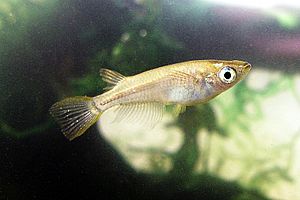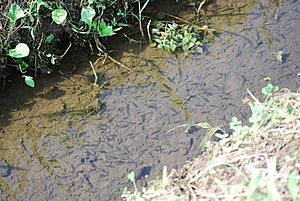Japanese rice fish facts for kids
Quick facts for kids Japanese rice fish |
|
|---|---|
 |
|
| Oryzias latipes | |
| Conservation status | |
| Scientific classification | |
| Synonyms | |
|
The Japanese rice fish (Oryzias latipes), also called the medaka, is a small fish from Japan. It belongs to a group of fish called ricefish. These tiny fish, which grow up to about 3.6 cm or 1.4 in long, live in many places. You can find them in rice paddies, marshes, ponds, and slow-moving streams. They can even live in tide pools!
Medaka are special because they can live in both fresh water and slightly salty water (called brackish water). People like to keep them as aquarium pets because they are tough and have pretty colors. In the wild, they are often creamy-white or yellowish. But fish raised for aquariums can be white, creamy-yellow, or orange. Scientists have even made some medaka glow bright yellow, red, or green! These are like GloFish, but they are not allowed to be sold in the EU. Medaka have been popular pets in Japan since the 1600s. After a female medaka lays her eggs, she carries them attached to her body near her tail fin for a while. Then, she places them on plants or other things in the water.
Contents
Medaka Life and Habitat
Medaka fish live in small ponds, calm rivers, and rice fields. They are very tough and can survive in water temperatures from 3–42 °C or 37–108 °F. However, they are happiest when the water is between 15–28 °C (59–82 °F).
These fish are helpful to humans because they eat young mosquitoes and tiny water creatures called plankton. A female medaka can lay 10 to 20 eggs at a time. In a lab, they can even lay eggs every day! They usually lay eggs in spring and summer, often around water plants in rice fields. It takes about 4 to 10 days for an egg to hatch.
Medaka have special kidneys that let them live in both fresh and salty water. In the wild, they usually live for about 2 years. But in a lab, they can live for 3 to 5 years. Medaka like to live in groups, and they can even recognize other individual medaka fish!
Medaka Family and Where They Live
Scientists used to think that O. latipes lived in many parts of East Asia. But now, they know that most of those fish are actually different species. This means the true O. latipes only lives in Japan. You can find them in eastern and southern Honshu, Shikoku, Kyushu, and some smaller southern islands.
Other fish that look similar were once thought to be O. latipes. For example, O. sakaizumii lives in northwestern Honshu, Japan. And the O. sinensis lives in China, west Korea, and parts of Southeast Asia. Scientists are still studying some populations to figure out exactly which species they are.
Sometimes, medaka have been moved to new places where they don't naturally live. For example, they were brought to Hokkaido in northern Japan. Other reports of medaka being introduced around the world often turn out to be the Chinese rice fish instead.
How Japanese Medaka Populations Spread
Scientists have studied the genes of medaka fish. They found that the medaka in southern Japan came from the northern Kyushu area and then spread to Honshu. The medaka in northern Japan came from the Tajima-Tango region and spread along the Sea of Japan coast.
There are nine known groups of O. latipes in Japan. These groups have sometimes mixed because people have moved fish around. This mixing can make the local fish less unique.
Medaka in Science
The Japanese rice fish is very important in science. It is a "model organism", which means scientists study it to learn about biology. They use medaka a lot in toxicology, which is the study of how chemicals affect living things.
Medaka are easy to raise in labs. They have a short time between generations and lay many eggs. They can also handle cold temperatures and are easy to ship. Scientists have studied almost everything about medaka. This includes how their colors are passed down, how they lay eggs, what they eat, how they get sick, how they grow from embryos, and where they live.
Medaka have a smaller genome (their genetic blueprint) than some other popular lab fish like the zebrafish. They also grow up faster and can live in a wider range of temperatures.
It's also fairly easy to make genetically modified medaka. Scientists have changed medaka to make human hormones or to glow green, yellow, or red. There are also many natural changes (mutations) that happen in medaka. For example, some medaka don't have scales, and some have extra-long fins.
Medaka in Space
The medaka holds a special record: it was the first vertebrate (animal with a backbone) to mate in space! This happened on the Space Shuttle Columbia in 1994. The eggs hatched into healthy baby fish. Medaka went to space again in 2012 on a Soyuz spacecraft. They lived in an aquarium on the International Space Station.
Medaka for Genetic Studies
Scientists can create "inbred lines" of medaka. This means they breed fish that are very closely related over many generations. This helps them study genes more easily. It's simpler to do this with medaka than with other animals like zebrafish or mice. By 1979, scientists had already made 10 different inbred groups of medaka. This made medaka a very useful animal for genetic research.
Medaka Reproduction
Medaka lay eggs every day, which is great for studying how animals reproduce. Also, the medaka was the first non-mammal animal where scientists found the gene that decides if it will be male or female (called DMY). Scientists can even change their sex using certain hormones. Male and female medaka also look a bit different from each other.
Medaka and the Immune System
Scientists learned that special cells called T-lymphocytes go to the thymus gland in medaka. This discovery helped them understand that this process happens in many different animals with backbones, not just mammals.
Protecting Medaka
Medaka's Status
The medaka is listed as a "least-concern species" by the IUCN Red List. This means it's not in immediate danger of disappearing. It lives in a large area (755,000 square kilometers) and there are many of them. However, Japan's Ministry of the Environment considers it an endangered species in Japan. Many local groups in Japan are working to protect wild medaka.
What Threatens Medaka
There are two main problems for medaka: their homes are changing, and they are mixing with pet medaka. Modern farming methods are changing rice fields and water canals. This means there are fewer good places for medaka to lay eggs and live. Also, people have released pet medaka (called himedaka) into the wild. Himedaka are bright orange. When they mix with wild medaka, their babies are also bright. This makes them easier for predators to spot and eat. This can reduce the total number of wild medaka.
In 2011, scientists found that about 15% of wild medaka in Nara, Japan, had genes from himedaka. Other problems include invasive species like mosquitofish. These fish compete with medaka for food and space. One study found that mosquitofish even injured the tail fins of over 70% of medaka. This can stop medaka from finding mates and having babies.
In 2006, a type of genetically modified medaka that glows green was brought to Japan from Taiwan. Some of these glowing fish have been released into the wild. This can cause "genetic pollution" by mixing new genes into the wild medaka population. Scientists don't have an exact count of all medaka, but studies suggest there are still many of them.
Medaka's Importance in Japan
Medaka have been kept as pets in Japan for hundreds of years. Recently, they have become even more popular. Some rare types of medaka can be worth a lot of money, even over US$10,000! But common types, like himedaka, are much cheaper. There are now 456 different types of medaka that people can buy for their aquariums.
Medaka are not just pets; they are also used a lot in schools. Japanese elementary school classes often raise medaka. This helps students learn how to care for living things and appreciate the life cycles of animals.
See also
 In Spanish: Medaka común para niños
In Spanish: Medaka común para niños
- Mummichog (Fundulus heteroclitus), another fish that went to space in 1973




